These recipes for crispy skin salmon 2 ways, pan fried and broiled, are ready to be added to your weeknight dinner routine!
Buttery salmon with crispy skin is faster and easier to make than you might think, not to mention delicious and healthy.
These easy salmon recipes will get dinner on the table in less than 15 minutes. Let’s do this!
(As an Amazon Associate, I earn from qualifying purchases. Some of the links on this page may be affiliate links. If you purchase a product through an affiliate link, I’ll automatically receive a small commission at no additional cost to you.)
Crispy skin salmon
There’s just something about salmon with crispy skin. The buttery fish with it’s crispy cape is like a superhero for dinner: easy, fast and delicious.
And once you know how to cook salmon with skin, it’ll become part of your weeknight routine. It’s fast and easy to prepare and goes perfectly with many different sauces and sides.
I’ll walk you through everything from how to buy salmon, how to cook it, how to reheat it and what to do if you don’t like or want the skin.
How to buy salmon
Look for salmon with pink, firm, moist flesh. If it looks dry, faded or wrinkled, skip it. Once you’ve picked it out, ask the fishmonger if you can smell it. It should smell fresh and almost briny like the sea, if it smells at all. If it smells fishy, it’s already starting to go bad.
Farm raised vs. wild caught salmon
You’ll notice two types of salmon:
Farm-raised salmon: This is exactly what it sounds like – salmon grown in, yep, farms. They’re contained in cages or pens. Farm-raised salmon are given a processed, very questionable diet to produce bigger fish:
Farmed salmon are fed pellets made out of fish oil and smaller fish, ground-up chicken feathers, poultry litter (yes, that’s poop), genetically modified yeast, soybeans and chicken fat. (Tampa Bay Times)
Also, the cramped conditions makes it easier to spread contamination and parasites, which then requires antiobiotics which results in antiobiotic-resistant organisms.
Compared to wild caught salmon, they have higher levels of saturated fat and omega-3 fatty acids (which fight inflammation), but also much higher rates of omega-6 fatty acids (which promote inflammation).
So all that doesn’t sound great! But luckily, there are fish farms getting it right, with smaller populations of salmon in large pens, no antibiotics, pesticides or growth hormones, and traceability to track the salmon’s source.
Wild caught salmon: Wild caught salmon are found in their natural environment, eating other organisms. They have less saturated fat and omega-6 fatty acids than farm-raised salmons and higher levels of zinc, potassium and iron.
This information isn’t to judge anyone for buying farm-raised salmon or dissuade people from eating salmon. But I believe in learning where our food comes from and how it’s raised. Information makes us smart and being smart is cool! (10-year-old me is cringing at current me right now.)
How to cook crispy skin salmon
I know, I know: can we just get to the cooking part already? The sooner we get to cooking, the sooner we get to eating.
There are two fast, easy ways to get succulent salmon with crispy skin on your dinner table in less than 15 minutes:
Pan-fried (or pan-seared) salmon: You just need a heavy skillet, some oil (I use avocado oil) and maybe a splatter guard if you have one.
I prefer to use a heavy non-stick skillet. The skin gets crispy without the flesh sticking the the pan. You really don’t want that.
It’s simply a matter of searing it on one side, flipping it and searing it on the other. The recipe walks you through the heat, the time, etc.
This is a fairly straightforward method. Unlike broiled salmon, searing the salmon in a skillet means the flesh side gets a nice layer of caramelization to add to the flavor.
Just watch out when you flip the salmon. The fillets might cause the oil to splatter, which is where the splatter guard comes in handy. Or you just might have to wipe down your stovetop afterward. Such is life.
Broiled salmon: Broiling overall is a highly underrated, under-utilized cooking method. I think a lot of people are actually kind of scared of their broilers or don’t know how to use them.
But fear not! Broiling salmon is just as easy as cooking it in the skillet, plus it frees up stovetop space for other things you might be cooking.
It’s simply a matter of lining and greasing a baking sheet (I use avocado oil spray), broiling one side of the salmon, flipping them and broiling the other side.
Sometimes I use a regular sized baking sheet, sometimes I use what’s called a quarter sheet pan. Either way is fine.
You’ll broil it skin-side up until the skin gets blistery bubbles. Then you just flip it until the other side is cooked through.
That’s it! Easy-peasy!
What to do if you don’t want the salmon skin
It’s actually easier to remove the skin once the salmon is cooked. When it’s cooled enough to handle, simply peel the skin off and season the newly-exposed flesh.
Making crispy skin salmon ahead of time
Salmon with crispy skin is best eaten immediately. If you have leftovers, you can re-crisp the skin in a skillet or under the broiler for a few minutes. Then flip the salmon to give it one or two more minutes on the flesh side to warm it up. Don’t cook it too long or it’ll dry out.
If you don’t like the skin or it doesn’t get crispy again, it’s easy to separate the salmon from the skin.
Using frozen salmon
I use frozen salmon all the time! Simply thaw in the fridge overnight (or per the package directions). Just be sure to really pat the salmon dry of excess water. Proceed with either method.
What to serve with crispy skin salmon
You can serve similar sides with either pan fried or broiled salmon. If you can’t use your oven and broiler at the same time, you can still roast veggies and then broil your salmon when they’re done. The salmon takes so little time the veggies will still be warm by the time it’s done.
An simple side dish would be this Easy Roasted Asparagus with Lemon.
Or if you want something more fun and vibrant, there’s this Rainbow Crunch Salad with Almond Butter Dressing.
I couldn’t pass up recommending these Bacon Ranch Crispy Smashed Potatoes. If you get some of the bacon and ranch dressing on the salmon, all’s the better.
Or this refreshing orange avocado salad would turn this salmon into a colorful, refreshing and filling meal.
Any one of these 4 ways to cook parsnips would also be great. Crispy skin salmon atop buttery mashed parsnips is not a bad way to unwind on a Tuesday.
If you want to top that salmon with a delicious sauce, here’s 10 sauce recipes you can make while the salmon is cooking.
Other recipes you might like:
- Potato Chip Crusted Salmon
- Sheet Pan Lemon Salmon with Pesto
- Spiced Butter Baked Cod with Green Beans
- Creamy Mustard Pork Chops with Asparagus
- Creamy Lemon Chicken, Olives and Artichokes
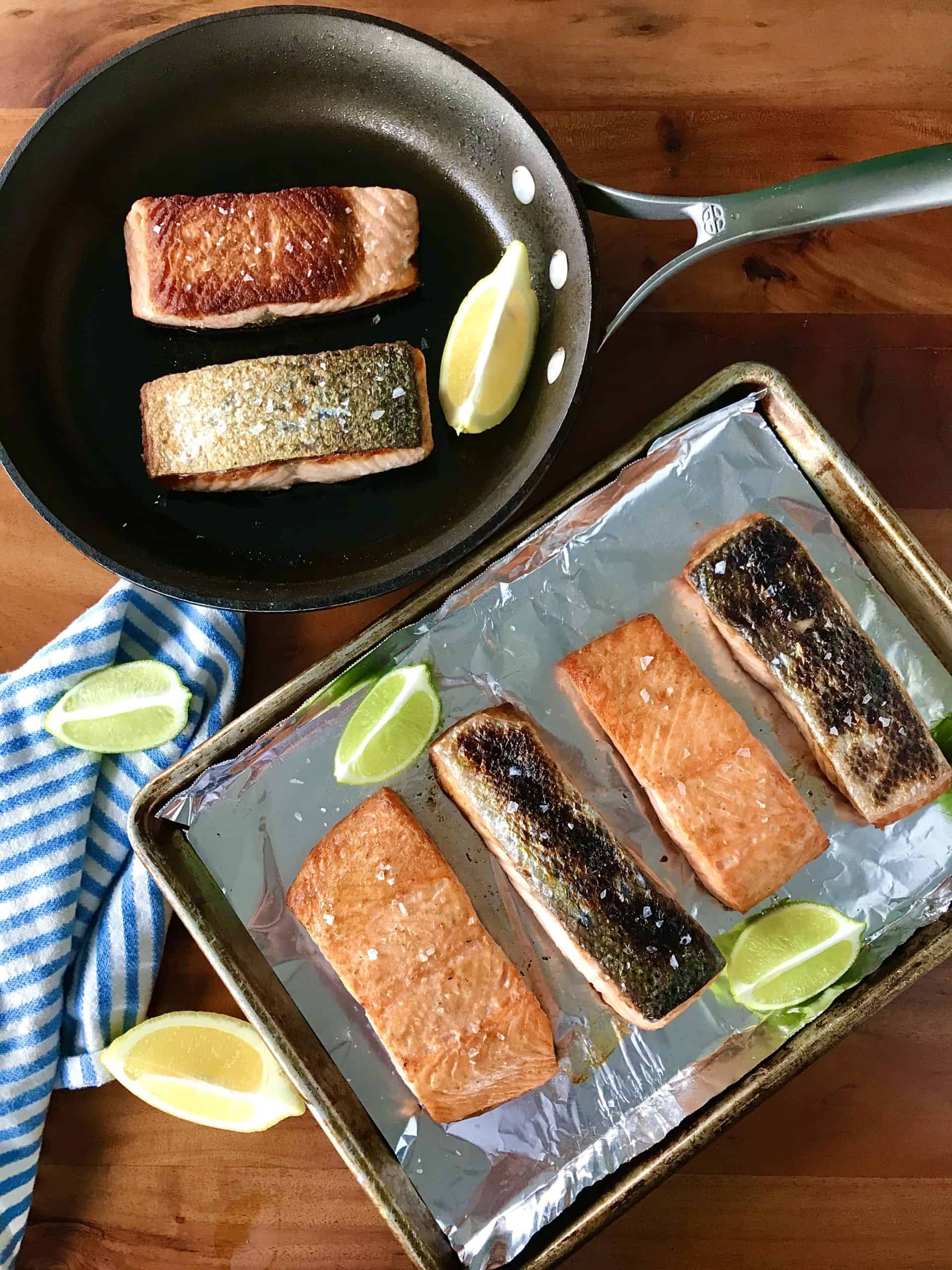
Crispy Skin Salmon 2 Ways: Pan Fried and Broiled
Ingredients
For pan-fried salmon:
- 2-3 tablespoons avocado oil
- 4 (6 oz.) salmon fillets with skin
- fine sea salt
- flaky sea salt
- freshly ground black pepper
- lemon or lime wedges (optional)
For broiled salmon:
- avocado oil spray or other cooking spray
- 4 (6 oz.) salmon fillets with skin
- fine sea salt
- flaky sea salt
- freshly ground black pepper
- lemon or lime wedges (optional)
Instructions
For pan-fried salmon:
- Heat a medium/large heavy skillet over medium-high heat. Add 2-3 tbsp. avocado oil (depending on the size of the pan) and let it get hot until it shimmers and runs around the pan when you swirl it by the handle.
- Pat the fillets dry and season the flesh side with the fine sea salt. Add them to the hot pan, skin side down. (Be careful with the hot oil.) Cook for 4-5 minutes, until the skin gets darker and crisp but not burnt.
- Use a thin spatula and one other utensil (fork, wooden spoon, etc.) to help flip each fillet. The oil might splatter as the fillets land on the flesh side. Cook for another 4-5 minutes. The flesh should change from a bright pink to a softer pink.
- If your fillets are especially deep, you might be able to tell from the sides that they're not cooked through yet. To finish them off but avoid overcooking, carefully tip each fillet over onto its side to make sure all surfaces are cooked. Cook the sides as necessary for one minute. A thermometer (probe or instant) inserted in the thickest part of a fillet should read 125°.
- Remove the fillets from the skillet and let rest for 5 minutes. Sprinkle the skin with flaky sea salt, freshly ground black pepper and a squeeze of lemon or lime, if desired.
For the broiled salmon:
- Heat the broiler to high.
- Line a baking sheet with foil and spray with avocado oil spray or spray of choice.
- Pat fillets dry and season the flesh side with fine sea salt. Broil skin-side up for 4-5 minutes. The time depends on how close your food is to the broiler. Check at 4 minutes to be safe. The skin will have some darker, bubbly spots and look crisp but shouldn't be burnt. If it doesn't look much different, continue to broil, checking every 2 minutes.
- Flip the fillets and broil flesh-side up for 4-5 minutes. The flesh should change from a bright pink to a softer pink. If your fillets are especially deep, you might be able to tell from the sides that they're not cooked through yet. To finish them off but avoid overcooking, carefully tip each fillet over onto its side to make sure all surfaces are cooked. Broil the sides as necessary for 1-2 minutes. A thermometer (probe or instant) inserted in the thickest part of a fillet should read 125°.
- Remove the baking sheet from the broiler and let rest for 5 minutes. Sprinkle the skin with flaky sea salt, freshly ground black pepper and a squeeze of lemon or lime, if desired.


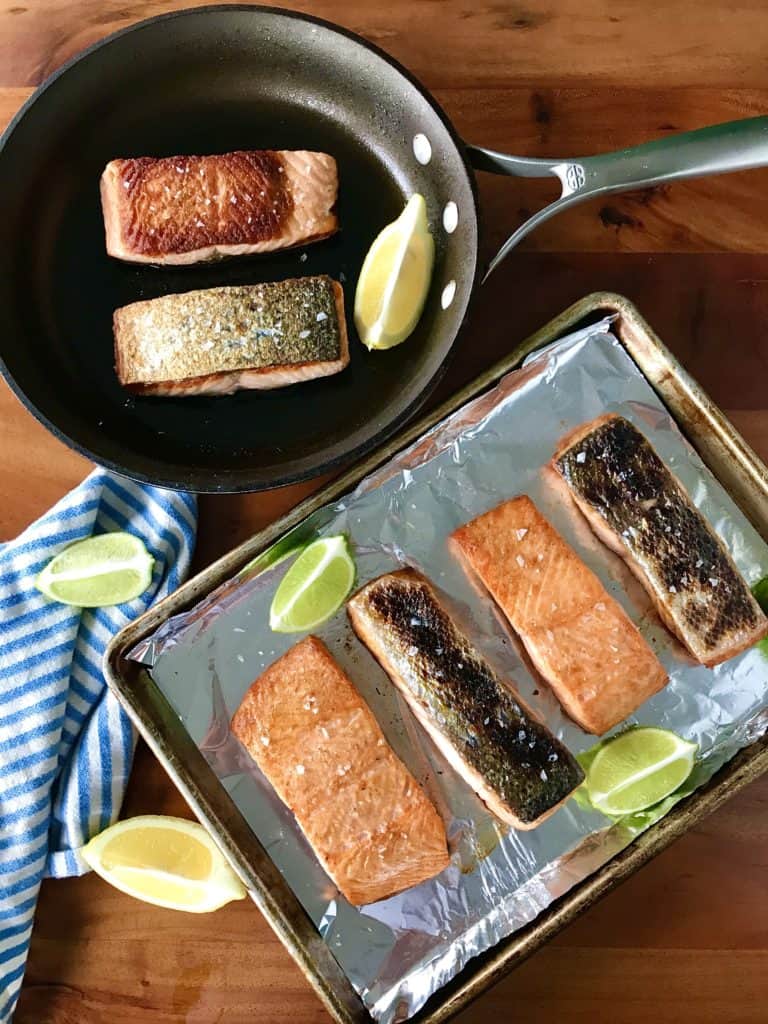
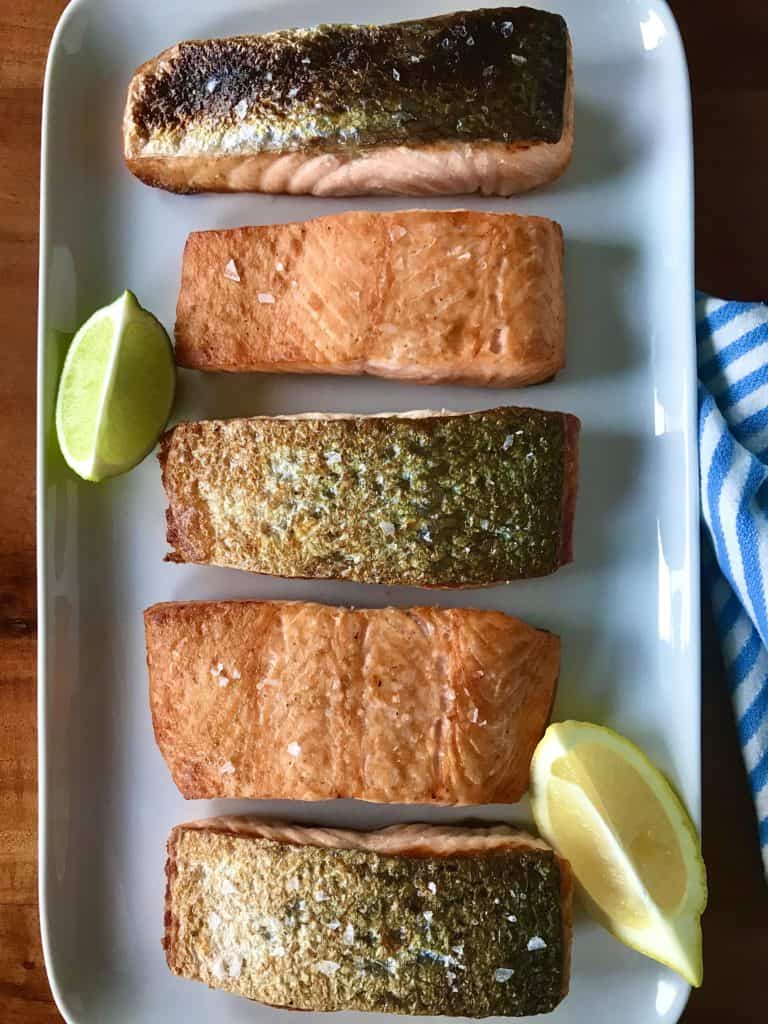
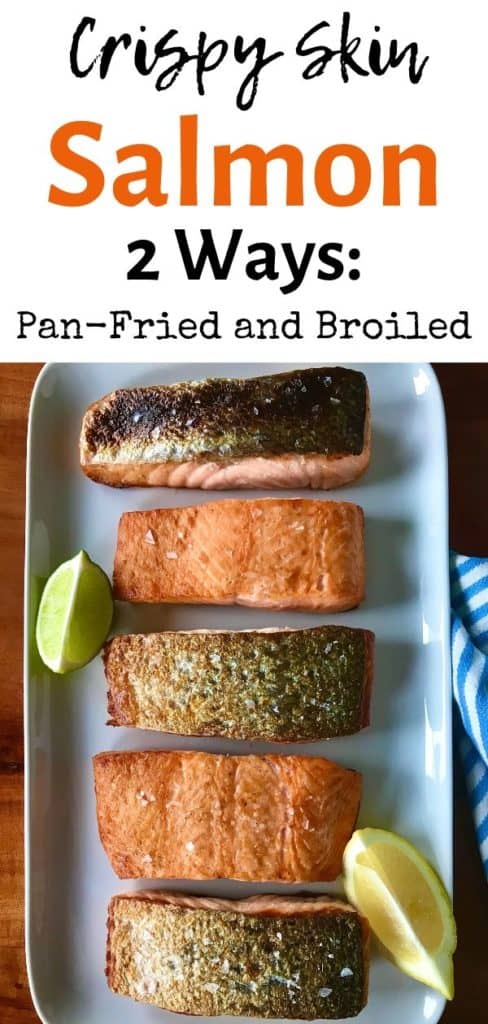
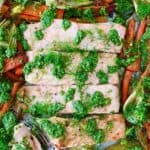
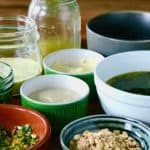

Janice says
I followed the broiling instructions exactly. I had a feeling it wasn’t going to result in crispy salmon skin and I was correct. I’m not sure how it makes sense to start with skin side up and then flesh side up. That means at the end of the broiling process the skin will absorb any and all liquids at the bottom of the pan. It’s not crispy at all. Bit disappointed because that was specifically what I was searching for.
Paleo Gluten Free Guy says
Hi Janice,
So sorry to hear that. I’ve made it this way so many times without a problem. But you can definitely try it the other way around by broiling the flesh side first.
Enrique B. says
Thank you for the great recipe! The one thing I will do next time is cook the skin last instead of at first. I cooked steelhead trout and it was wonderful.
Paleo Gluten Free Guy says
So glad you liked it! Thanks for letting me know.
Luna Regina says
Thanks! Love all the tips and tricks!
Paleo Gluten Free Guy says
Thanks. I hope you find them helpful. 🙂
Andrea Metlika says
Both of these methods sound perfect to me. Wild caught Salmon is my absolute favorite fish. I can’t wait to make this crispy skin version.
Paleo Gluten Free Guy says
Thanks! I hope you enjoy.
Anita says
I especially love buying salmon when the skin is still attached. The crispy skin contrasting the soft meat is just so good. And simple seasoning like this recipe is my favorite way to enjoy salmon.
Paleo Gluten Free Guy says
Right? I love the contrasting textures.
Amy Chung says
We eat salmon on a regular basis so getting non farmed salmon is really important for us. It’s a tad more expensive but I think its worth it. Great tips on getting the skin crispy!
Paleo Gluten Free Guy says
Yeah, if it’s in the budget, I definitely think it’s worth it, too. Thanks!
Krissy Allori says
I love crispy skin on Salmon! These 2 recipes look so good. I’ll be adding them to my menu in the next couple of weeks.
Paleo Gluten Free Guy says
Awesome! Let me know if you try them. 🙂
Carrie Robinson says
I am loving both of these methods for cooking salmon! Looks delicious.
Paleo Gluten Free Guy says
Thanks so much!
Carol Little R.H. @studiobotanica says
Love your ideas for crispy skin salmon! I tend to purchase wild fish when possible.
I don’t have a Whole Foods store near my home but will definitely think of salmon when I have
the chance to go.. I like to support people who are raising our food with conscience.
Paleo Gluten Free Guy says
That’s so great! Whole Foods was just an example. I’m sure there are plenty more sources.